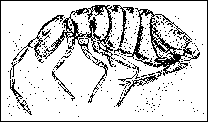

 |
||||||||||||
 |
||||||||||||
| Earthworm Biology and Production | ||||||
| Page 8 of 9 | Pages: 1 . 2 . 3 . 4 . 5 . 6 . 7 . 8 . 9 | |||||
Control A control program is designed to keep pest populations below damaging levels. The best control for earthworm mites is prevention, and proper management thus becomes the most important aspect of mite control. High earthworm mite populations are nearly always associated with one or more of the following conditions: (1) over-watering, (2) over-feeding, and (3) feeding of wet or fleshy garbage. Bed conditions ideal for worm production are not conducive to high mite populations. Conversely, beds with high mite populations are being improperly managed for optimum worm production. Feeding schedules should be maintained so that all feed is consumed in a few days, thus preventing accumulations of "soured" feed in the beds. Feeding schedules will vary depending upon time of year and prevailing temperatures. Worm beds with poor drainage frequently become too wet, creating conditions less favorable to worms and more favorable to mites. Watering schedules should be adjusted to prevailing weather so as not to keep the beds too wet. High mite populations are frequently associated with the feeding of garbage, lettuce leaves, and other vegetable refuse having high moisture content. Use of such feed should be discontinued until mites are under control and further use should be with discretion. When mites start to build up, uncover the beds and expose them to the sun for a few hours. Cut down on amounts of feed and water. In small worm beds one can remove large numbers of mites by placing wetted newspapers or burlap bags on the bed surfaces; mites will accumulate on them and can then be removed. By repeating this procedure, substantial population reductions can be accomplished. When mite and other insect populations build up in the beds, some growers attempt to reduce them by a heavy watering to force the pests to the surface and then burning them with a hand-held torch. However, physical or chemical removal of mites will be of only temporary benefit unless bed conditions are altered to create a less desirable environment for the mites. Ants Several species of ants may occasionally be a problem or annoyance to the worm grower. Ants are attracted to high-concentrate feed in worm beds, and some species are reported to feed on eggs and small worms. Physical barriers can be placed around worm beds to keep ants out. Ants can be controlled with insecticidal sprays and baits, but precautions should be taken to prevent injury to the worms by treatment. Springtails Springtails (Figure 3) are small, white to gray oblong insects that jump when disturbed. They can sometimes become abundant enough to turn the surface of a bed white. Apparently, their greatest harm is feed consumption, but they have been observed to attack and consume weak or dead worms. When springtails are abundant, worms stay deep in the beds and refuse to come to the surface to feed (as described in "Mites"). The general management procedure discussed under mite control is also the best procedure for springtail control. Chemical control of springtails has not been effective. 
Figure 3: The springtail, Collembola. White Worms Small, white-tan, threadlike worms called planaria (most common are Bipalium sp.) are often found in earthworm beds. They are common in fecal material and eventually get into worm production beds via manures. These species are considered to be serious predators of earthworms in the warm, humid environment of Florida, and have been responsible for total destruction of worm populations in extreme cases. Basic information about these worms can be found in a publication of the Florida Department of Agriculture and Consumer Services, Division of Plant Industry: "Land Planarians," Nematology Circular No. 75, by R. P. Esser. To obtain a copy, contact FDACS-DPI at P.O. Box 147100, Gainesville, FL 32614-7100. more... |
 |
|||||
| About Us :: Message Board :: Chat | |||||
| Library :: Photo Gallery :: Links & Resources :: Breeders & Sponsors :: Merchandise | |||||
| Website designed by: EthanCote.com | © 2001-2004, SimplyDiscus.com. All Rights Reserved. | ||||